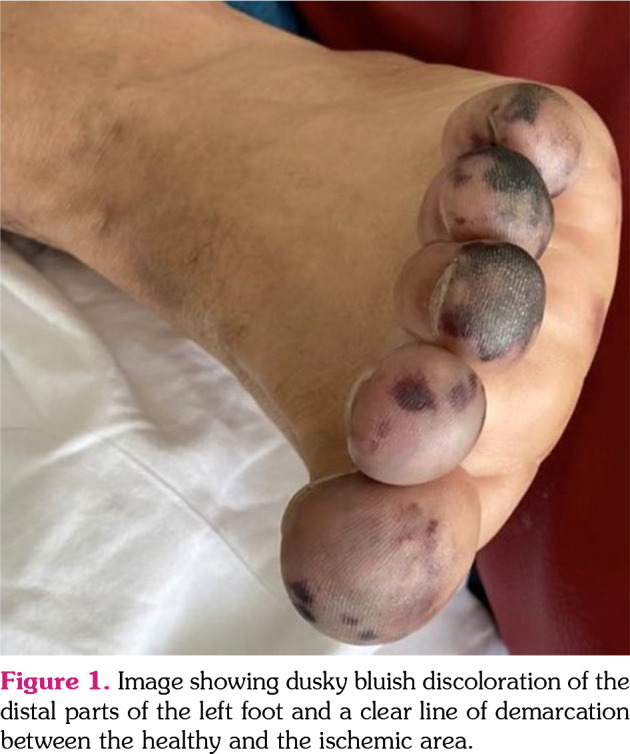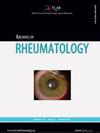covid -19诱导的抗磷脂综合征手指缺血
IF 1.1
4区 医学
Q4 Medicine
引用次数: 0
摘要
本文章由计算机程序翻译,如有差异,请以英文原文为准。

COVID-19-induced digital ischemia in antiphospholipid syndrome.
A 37-year-old man, a long-standing history of primary antiphospholipid syndrome (APS), was referred to our department due to a five-day history of skin discoloration in the left foot fingers that were painful. He was diagnosed as having primary APS based on antiphospholipid antibody positivity in repeated measurements at 12-week intervals and deep vein thrombosis of the lower extremity. A detailed clinical history revealed dry cough and myalgia. He also denied smoking or using any medications other than vitamin K antagonist. Physical examination revealed acral ischemic lesions the left foot (Figure 1). Pulses of lower limb were palpable. Doppler sonography of the lower limbs and electrocardiogram showed no abnormalities. Nasopharyngeal swab was positive for novel coronavirus 2019 disease (COVID-19) and chest X-ray showed peripheral consolidations without respiratory distress. The blood test revealed elevated acute phase reactants, D-dimer level, and fibrinogen degradation products. The international normalized ratio (INR) was 2. No venous thromboembolism was found in association, embolic causes were ruled out, and positivity for antiphospholipid antibodies (anticardiolipin immunoglobulin [Ig] M 99 U/mL and IgG >120 U/mL) was confirmed. The patient was followed with the diagnosis of digital ischemia in the context of COVID-19 and was initiated hydroxychloroquine (HCQ) and his prior treatment was switched for low-molecularweight heparin (LMWH). The lesions and
求助全文
通过发布文献求助,成功后即可免费获取论文全文。
去求助
来源期刊

Archives of rheumatology
Medicine-Rheumatology
CiteScore
2.00
自引率
9.10%
发文量
15
期刊介绍:
The Archives of Rheumatology is an official journal of the Turkish League Against Rheumatism (TLAR) and is published quarterly in March, June, September, and December. It publishes original work on all aspects of rheumatology and disorders of the musculoskeletal system. The priority of the Archives of Rheumatology is to publish high-quality original research articles, especially in inflammatory rheumatic disorders. In addition to research articles, brief reports, reviews, editorials, letters to the editor can also be published. It is an independent peer-reviewed international journal printed in English. Manuscripts are refereed by a "double-blind peer-reviewed" process for both referees and authors.
Editorial Board of the Archives of Rheumatology works under the principles of The World Association of Medical Editors (WAME), the International Council of Medical Journal Editors (ICMJE), and Committee on Publication Ethics (COPE).
 求助内容:
求助内容: 应助结果提醒方式:
应助结果提醒方式:


